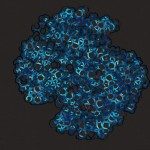Lien vers Pubmed [PMID] – 20545845
Mol. Microbiol. 2010 Aug;77(3):628-41
Signal transduction ATPases with numerous domains (STAND) are sophisticated proteins that integrate several signals and respond by building multimeric platforms allowing signalling in various processes: apoptosis, innate immunity, bacterial metabolism. They comprise a conserved nucleotide oligomerization domain (NOD), which functions as a binary switch that oscillates between the OFF (ADP-bound) and the ON (ATP-bound) conformation, and non conserved sensor and effector domains. Transition from the OFF form to the ON form strictly depends on the binding of an inducer to the sensor domain. The interaction of the inducer with this domain was studied in MalT, a model STAND protein. MalT sensor domain has a SUPR (superhelical repeats) fold resembling a cylinder with a central cavity. The cavity was subjected to an alanine-scanning approach, and the effects of the alanine substitutions on inducer binding and transcription activation were analyzed. This work unambiguously showed that the inducer maltotriose binds inside the cavity, and a patch on the inner surface was proposed to be the primary maltotriose binding-site. Furthermore, limited proteolysis suggested that maltotriose binding changes the conformation of the sensor domain.


